Everything About Glasses (& How to Choose a Pair)
Home /
Last Updated:
There are different types of glasses that help with different vision problems. An eye doctor will determine the best type for a patient, depending on the results of a vision examination.
Anyone who is having trouble seeing should visit their eye doctor for an evaluation. If it is determined they have a vision condition, such as nearsightedness or farsightedness, eyeglasses are a viable option for helping to improve their vision.
Table of Contents
It was around 1284 when the first pair of eyeglasses that people could wear were invented. They work to improve vision, and they are ideal for several visual conditions, such as nearsightedness, astigmatism, and farsightedness.
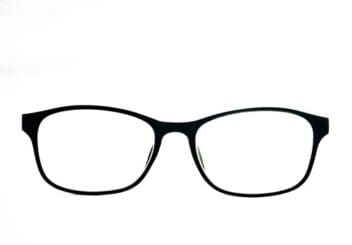
To put it simply, glasses work by either subtracting or adding focusing power to the lens and cornea components of the eye.
For certain vision issues, there are other options in addition to eyeglasses. For example, some people may benefit more from LASIK surgery or contact lenses.
Once a patient and doctor decide that eyeglasses are the best choice, there are some steps to take to choose the right eyeglasses.
History of Glasses
The first eyeglasses that people could wear were created in 1284 in Italy. They were two small magnifying glasses. The frames were made from metal, bone, or leather.
The first eyeglasses could only help with presbyopia and hyperopia. Eyeglasses for myopia did not get created until the early 1400s.
You deserve clear vision. We can help.
With 135+ locations and over 2.5 million procedures performed, our board-certified eye surgeons deliver results you can trust.
Your journey to better vision starts here.
The principle of convex and concave lenses started in the 17th century. In 1825, Sir George Airy invented lenses for astigmatism known as cylindrical lenses. In 1784, Benjamin Franklin devised bifocal lenses.
How Do Eyeglasses Work?

Eyeglass lenses subtract or add to the focusing abilities of the lens and cornea of the eyes.
Convex lenses are prescribed for nearsightedness. They push the focal point to the retina by bending the light toward the lens’ top and bottom.
Concave lenses are for farsightedness. These adjust the focal point by spreading light for the lens’ center.
Concave lenses are minus, and convex lenses are plus. When buying glasses, the prescription will say “plus” or “minus” to indicate if the lenses are for nearsightedness or farsightedness.
The shape and strength of the lens play a role in which vision issues they are best for. The strength of the lens shows how much the lens bends the light. Diopters are used to measure the strength. The shape of a lens is either spherical, compound, or cylindrical.
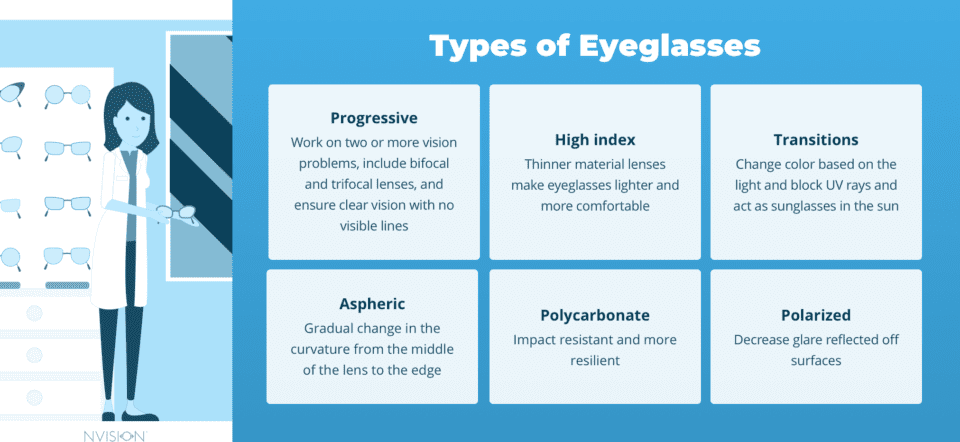
What Are the Different Types of Eyeglasses?
There are different types of lenses for eyeglasses available in 2022. The best type depends on personal preference and the vision problems a person has. The three primary lens types include:
- High index. These lenses use a thinner material to correct vision. This can make eyeglasses more comfortable since they will be lighter.
- Progressive. These lenses work on two or more vision problems. They include bifocal and trifocal lenses. They ensure clear vision with no visible lines.
- Transitions. These lenses change color based on the light. They block UV rays and act as sunglasses in the sun. At night and indoors, however, they are clear.
Other lens types include:
- Aspheric. Conventional lenses have the same curve on the surface. Aspheric lenses have a gradual change in the curvature from the middle of the lens to the edge.
- Polarized. These lenses cause clearer and sharper images due to decreasing glare reflected off surfaces.
- Polycarbonate. This lens is ideal for active people since they are impact resistant and more resilient.
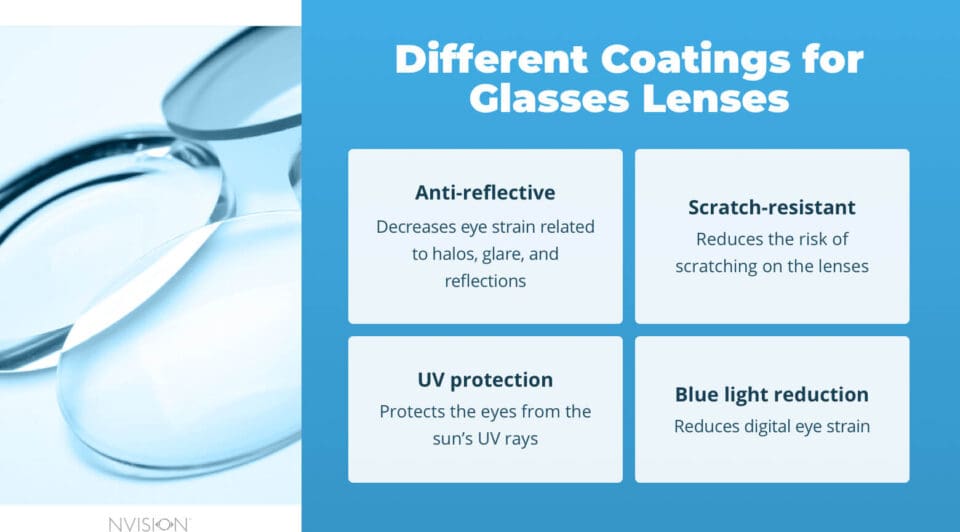
There are different coatings people can put on their lenses, such as:
- Anti-reflective. This coating decreases eye strain related to halos, glare, and reflections.
- Scratch-resistant. This coating reduces the risk of scratching on the lenses.
- Blue light reduction. People who work on computers might consider this coating since it reduces digital eye strain.
- UV protection. This coating protects the eyes from the sun’s UV rays.
When to Consider Eyeglasses
It is estimated that over 150 million people in the United States wear eyeglasses.
When someone needs glasses, they do not always have symptoms. However, certain symptoms indicate that someone should see their eye doctor.

- Double vision
- Headaches
- Halos or auras around objects in bright light
- Distorted vision
- Blurred vision
- Fuzziness around object edges
- Squinting
- Eye strain
- Difficulty driving or seeing at night
There are four primary eye issues for which people wear eyeglasses:
- Presbyopia: This describes near vision loss due to aging. The lens of the eye gets older, causing this condition.
- Myopia: This describes nearsightedness. People find it hard to see far-away objects sharply.
- Hyperopia: This describes farsightedness. People find it difficult to see close objects clearly.
- Astigmatism: With this condition, there is an asymmetric curve of the cornea.
Alternatives to Eyeglasses
Eyeglasses aren’t your only option if you have low vision. Alternatives to eyeglasses include the following:
- Contact lenses
- LASIK
- PRK
- Implantable contact lenses
Contacts vs. Eyeglasses
In the U.S., about 24 million people wear contact lenses.
The choice between eyeglasses and contacts ultimately comes down to personal preference.
Eyeglasses come with lens and coating options. They also are easier to maintain, can adjust how much light gets into the eye, are less expensive, and reduce the risk of infection since no one has to touch their eye to put them on.
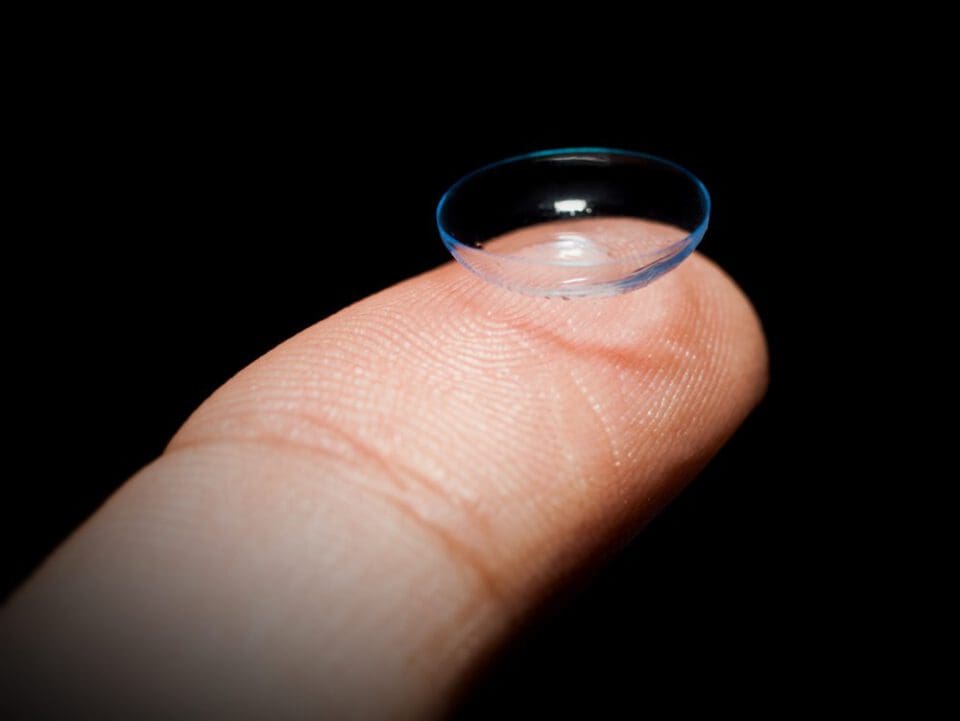
You deserve clear vision. We can help.
With 135+ locations and over 2.5 million procedures performed, our board-certified eye surgeons deliver results you can trust.
Your journey to better vision starts here.
LASIK vs. Eyeglasses
Some people who wear glasses can reduce their reliance on them by getting LASIK. LASIK can be used for astigmatism, farsightedness, and nearsightedness.
The following may exclude people from having LASIK:
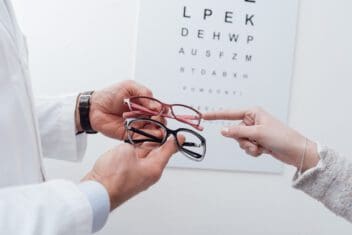
- An eye disease that progressively thins the cornea and deteriorates vision
- Keratitis, herpes simplex of the eye, and uveitis
- Large pupils
- Cataracts
- Eyelid disorders
- Eye injuries
- Glaucoma
- Dry eyes
- Severe refractive error
- Presbyopia
People with these issues should talk to their eye doctor to determine if LASIK is ideal or not. If LASIK cannot be performed, continuing to wear eyeglasses is often the best option.
How to Choose a Pair of Eyeglasses
With so many options to choose from in 2022, it can initially feel overwhelming when someone starts to shop for glasses. The first step is considering the different lens types and coatings to see which would benefit your vision the most.
The next step is determining the best eyeglasses for your face shape.
- Oval: Walnut-shaped frames that are not overly narrow or deep work well.
- Heart: Wider at the bottom, rimless, and light-colored frames are best.
- Oblong: Frames with contrasting or decorative temples are ideal.
- Square: Narrow ovals and frames with less depth than width are a good choice.
- Diamond: Consider cat-eye or rimless frames.
- Base-down triangle: Cat-eye frames and heavily accented frames work well.
- Round: Rectangular frames and those with more width than depth are ideal.
Top Eyeglass Brands & Manufacturers
In 2022, you have a plethora of options when it comes to eyeglass brands. These frame manufacturers are popular:
- Ace & Tate
- Oliver Peoples
- Tom Ford
- Oakley
- Ray-Ban
While buying glasses directly from your eye doctor’s office is generally the best option due to personalized fittings and the expert advice you get, you can still find a wide range of brand options at these online retailers:
- Warby Parker
- Roka
- GlassesUSA
- Overnight Glasses
- Eyeglasses.com
Eyeglass Costs
The cost of eyeglasses can range greatly, depending on the chosen frames and lenses. The average price for a pair of eyeglasses in the United States is about $200.
Vision insurance can offset the cost of eyeglasses, but there is often a cap on the amount they will cover for eyeglasses. For example, many plans cover one pair of glasses every two years, but they cap the amount at $150; any amount over $150 must be covered by the patient.
Caring for Eyeglasses
Once someone has glasses, proper care can ensure they last. This also protects the lenses so issues, such as scuffs and scratches, do not obstruct vision.
When cleaning eyeglasses, there are certain actions to avoid to protect them.
- Do not use paper products to clean the lenses. This could result in scratches since paper products are made of wood pulp.
- Never hold the lenses. Only touch the frames.
- Never use regular cleaning products for lenses.
- Avoid using clothing to wipe the lenses since any particles on clothing could harm the lenses.
Follow these tips to ensure safe cleaning of eyeglasses:
- Use a cleaner that is designed for eyeglasses.
- Use a cotton cloth or one designed for eyeglasses
You deserve clear vision. We can help.
With 135+ locations and over 2.5 million procedures performed, our board-certified eye surgeons deliver results you can trust.
Your journey to better vision starts here.
References
- Eyeglasses and Contact Lenses. University of Rochester Medical Center.
- Types of Prescription Eyeglass Lenses. Western Michigan University.
- Eye Health Statistics. American Academy of Ophthalmology.
- Refractive Errors. Kellogg Eye Center.
- Eyeglasses and Contact Lenses. Stanford Children’s Hospital.
- LASIK Surgery: Is It Right for You? Mayo Clinic.
- Eyeglasses Cost. CostHelper Health.
This content is for informational purposes only. It may have been reviewed by a licensed physician, but is not intended to serve as a substitute for professional medical advice. Always consult your healthcare provider with any health concerns. For more, read our Privacy Policy and Editorial Policy.
